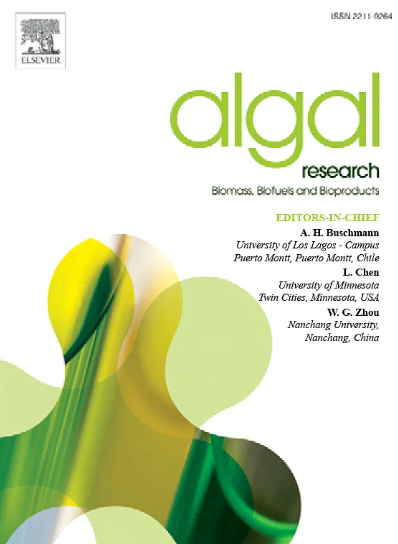Enhancement of properties of seaweed-based films by fatty acid incorporation: Preservation potential for cherry tomatoes
IF 4.6
2区 生物学
Q1 BIOTECHNOLOGY & APPLIED MICROBIOLOGY
Algal Research-Biomass Biofuels and Bioproducts
Pub Date : 2025-06-19
DOI:10.1016/j.algal.2025.104159
引用次数: 0
Abstract
This study aimed to enhance the properties of seaweed (Chondrus crispus) mucilage-based films by incorporating stearic acid (SA) at concentrations of 0, 5, 10, 15, and 20 % (w/w, based on polymer weight). The fabricated films were characterized for their physicochemical, mechanical, structural, and optical properties. Furthermore, the film-forming solution (containing 0 % and 20 % SA) was used to coat cherry tomatoes, and their quality characteristics were analyzed during 12 days of storage at 10 °C. SA incorporation led to significant (p < 0.05) improvements in water vapor barrier capacity (WVP) and elasticity (EAB), with concentrations above 10% showing comparable values for both properties (p > 0.05). Films with 5 % SA showed weak oxygen barrier properties, while films with higher SA concentrations demonstrated similar performance (p > 0.05) to the control. Moreover, increasing SA concentration led to a significant decrease in light transmittance. SEM analysis revealed that SA caused layering and lipid aggregation. Furthermore, the addition of SA resulted in the formation of new bands in XRD and changes in band intensities and positions in FTIR. Coating treatments limited the changes in the total soluble solids content, pH, and titration acidity of cherry tomatoes compared to the uncoated sample. While the matrix containing 20 % SA effectively preserved the quality of the cherry tomatoes, the SA-free coating (SA0) resulted in greater weight loss and softening compared to the uncoated tomatoes. In conclusion, SA incorporation enhances the mechanical, light barrier, and structural properties of seaweed-based films, and the 20 % SA film matrix is an alternative for preserving cherry tomatoes.
脂肪酸掺入对海藻基薄膜性能的增强:对圣女果的保鲜潜力
本研究旨在通过添加浓度为0、5、10、15和20% (w/w,基于聚合物重量)的硬脂酸(SA)来增强海藻(Chondrus crispus)粘液基薄膜的性能。制备的薄膜具有物理化学、机械、结构和光学性能。采用含0%和20% SA的成膜液包被圣女果,在10℃条件下贮藏12 d,分析其品质特性。SA合并导致显著的(p <;0.05)水蒸气阻隔能力(WVP)和弹性(EAB)的改善,浓度高于10%对这两种性能都显示出相当的值(p >;0.05)。含5% SA的膜表现出较弱的氧屏障性能,而含较高SA浓度的膜表现出类似的性能(p >;0.05)。此外,SA浓度的增加导致透光率显著降低。扫描电镜分析显示,SA引起分层和脂质聚集。此外,SA的加入导致XRD中形成新的条带,FTIR中条带强度和位置发生变化。与未包衣的样品相比,包衣处理限制了圣果总可溶性固形物含量、pH值和滴定酸度的变化。虽然含有20% SA的基质有效地保持了圣女果的品质,但与未涂覆的番茄相比,无SA涂层(SA0)导致了更大的重量损失和软化。综上所述,SA的加入提高了海藻基薄膜的机械性能、光阻隔性和结构性能,20% SA薄膜基质是保存圣女果的替代材料。
本文章由计算机程序翻译,如有差异,请以英文原文为准。
求助全文
约1分钟内获得全文
求助全文
来源期刊

Algal Research-Biomass Biofuels and Bioproducts
BIOTECHNOLOGY & APPLIED MICROBIOLOGY-
CiteScore
9.40
自引率
7.80%
发文量
332
期刊介绍:
Algal Research is an international phycology journal covering all areas of emerging technologies in algae biology, biomass production, cultivation, harvesting, extraction, bioproducts, biorefinery, engineering, and econometrics. Algae is defined to include cyanobacteria, microalgae, and protists and symbionts of interest in biotechnology. The journal publishes original research and reviews for the following scope: algal biology, including but not exclusive to: phylogeny, biodiversity, molecular traits, metabolic regulation, and genetic engineering, algal cultivation, e.g. phototrophic systems, heterotrophic systems, and mixotrophic systems, algal harvesting and extraction systems, biotechnology to convert algal biomass and components into biofuels and bioproducts, e.g., nutraceuticals, pharmaceuticals, animal feed, plastics, etc. algal products and their economic assessment
 求助内容:
求助内容: 应助结果提醒方式:
应助结果提醒方式:


